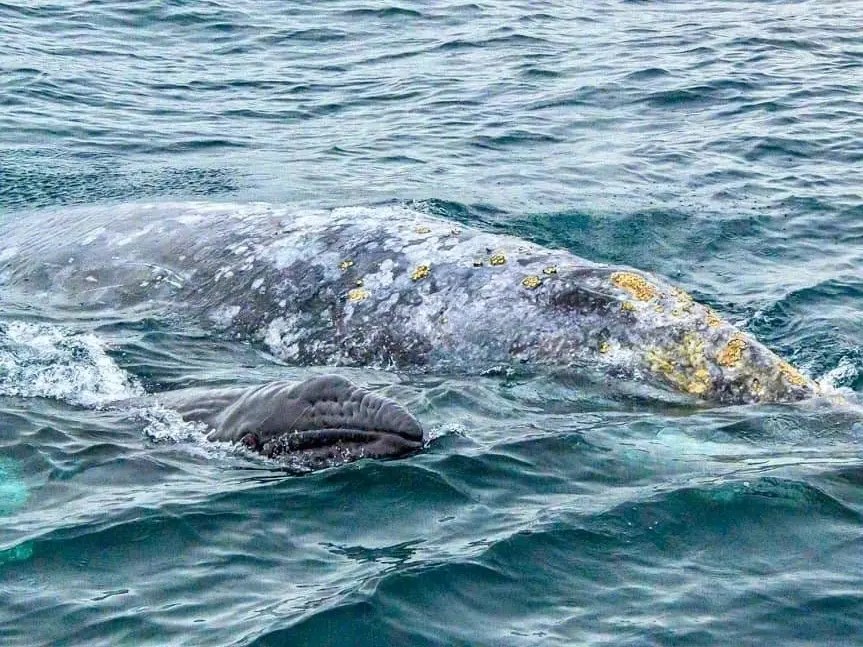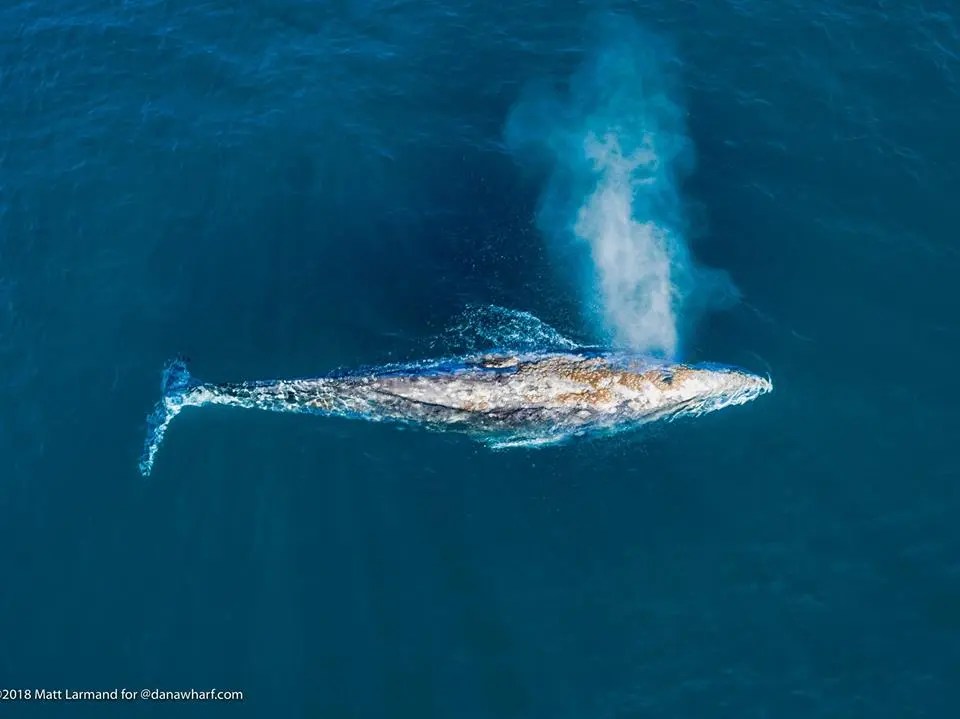Gray Whales: A Comprehensive Guide

Quick Facts about the Gray Whale
- Gray whales are one of the oldest baleen species, existing for around 30 million years.
- They have a mottled gray coloration on their skin, covered in patches of barnacles and whale lice, giving them a distinct and recognizable appearance.
- Gray whales have two rows of baleen plates in their upper jaw. These plates, made of keratin (the same material as human fingernails), allow the whale to filter-feed on small prey.
- These whales earn the nickname “gentle giants” and gain recognition for their curious and friendly behavior towards humans. They often approach boats during migration, making them a popular subject for whale-watching tours.
- Gray whale mothers are incredibly protective and nurturing of their calves. They are known to be affectionate and display maternal care for their young.
- Gray whales are bottom feeders. They feed by scooping sediment from the ocean floor and filtering out small prey, like amphipods, through their baleen plates.
- Gray whales lack a dorsal fin, typical of most baleen whales. Instead, they have a series of “knuckles” along their back.
Where do gray whales live?
The gray whale evolved from an extinct species of baleen whale that lived about 30 million years ago. This ancient species, the Balaenoptera Davidsonii, gave rise to several modern species, including the humpback, minke, and grays.
Gray whales first appeared in the North Pacific around 10–12 million years ago. At the time, they were mainly found in shallow coastal waters, but they eventually spread throughout the region.
Gray whales (Eschrichtius robustus) are primarily located off the west coast of North America in the North Pacific Ocean. They undertake one of the longest migrations of any mammal, traveling between their feeding and breeding grounds.
Where and when can I see a Gray Whale?
The best places to see gray whales will depend on the time of year and their migratory patterns. Gray whales migrate incredibly long distances between their feeding and breeding areas, making them visible in certain places at different times of the year. Here are some popular locations where you might be able to see gray whales:
- Baja California, Mexico: During the winter and early spring (from December to April), many gray whales migrate to the breeding and calving grounds along the western coast of Baja California, Mexico. Places like Magdalena Bay, San Ignacio Lagoon, and Scammon’s Lagoon are popular spots for whale-watching tours, where you can get up close to these magnificent creatures.
- Dana Point, California: During the winter months of December through February. Whales migrate south along the Southern California coast, making Dana Point an excellent place to see them. Learn more about the “Best Times to Go Whale Watching in Dana Point. “
- Oregon and Washington, USA: During the northbound migration in the spring (late March to June), some gray whales pass by the coasts of Oregon and Washington. Whale-watching tours are available in Depoe Bay (Oregon) and San Juan Islands (Washington).
- Alaska, USA: During the summer and fall (from June to October), gray whales can be found in the feeding grounds off the coasts of Alaska. Places like Kodiak Island, the Kenai Peninsula, and the Aleutian Islands offer opportunities for whale watching during this time.
- Sakhalin Island, Russia: Gray whales can also be seen along the northeastern coast of China (Sakhalin Island) during their feeding season in the summer and fall.

Can you see gray whales in Dana Point?
Yes, gray whales can be seen in Dana Point, California. The annual migration of gray whales is a popular event from December to May each year. Visitors to Dana Point can view the whales from the shore or take a whale-watching boat tour.
Where and how can I touch a gray whale in the open ocean?
It is illegal to touch a gray whale in the open ocean. Gray whales are protected under the Marine Mammal Protection Act, and it is illegal to approach them closer than 100 yards. Violating this law can result in a fine or even jail time.
How far do gray whales migrate?
Gray whales undertake one of the longest migrations of any mammal on Earth. They travel vast distances between their feeding and breeding grounds. The round-trip migration can cover over 12,000 miles (19,000 kilometers). Here’s a breakdown of the approximate distances they travel during their migration:
- Feeding Grounds to Breeding Grounds: During the summer and fall, gray whales feed in the cold, nutrient-rich waters of the Arctic and sub-Arctic regions. They primarily feed along the coasts of Alaska, Canada (British Columbia), Russia (Chukotka and Kamchatka), and the northeastern coast of China (Sakhalin Island). They begin their southward migration from these feeding grounds towards their breeding and calving grounds.
- Breeding and Calving Grounds: In winter and early spring, gray whales migrate to the warmer waters of the subtropical and tropical regions to breed and give birth to their calves. The primary breeding areas are along the western coast of Baja California, Mexico, in places such as Magdalena Bay, San Ignacio Lagoon, and Scammon’s Lagoon.
The distance between the feeding and breeding grounds can be approximately 5,000 to 6,000 miles (8,000 to 9,700 kilometers) one way. When you factor in the return journey to the feeding grounds, the total migration distance can exceed 12,000 miles (19,000 kilometers).
What does a gray whale sound like?
Gray whales make a variety of sounds that are used for communication and echolocation. Most of the gray whale’s vocalizations occur underwater and are only easily audible to human ears with specialized equipment. Researchers use underwater hydrophones to study and record these sounds to gain insight into the whales’ behavior and communication patterns.
- Song-like Melodies: Gray whales produce complex, melodic songs that can last several minutes. These songs (made of moans, groans, and whistles) happen during breeding season when the males try to attract females.
- Clicks and Pulsed Sounds: Gray whales emit rapid clicks and pulsed sounds, likely used for echolocation. They can navigate and locate food sources in dark or murky waters by sending out these sounds and analyzing the returning echoes.
- Social Sounds: Gray whales are highly social animals, and they communicate with each other using various sounds. These social sounds can include grunts, growls, and other vocalizations that help them maintain social bonds and coordinate group activities.
- Breaching and Slapping Sounds: When gray whales breach (leap out of the water) or slap their flukes or pectoral fins on the surface, they produce distinctive sounds heard both above and below the water. These actions serve as communication signals or be a form of play or territorial display.

How do gray whales sleep?
Gray whales have a unique way of resting, as they don’t sleep in the same manner as most other mammals. Marine mammals must remain conscious for certain essential functions even during rest periods. Gray whales rest or take short naps by logging — floating motionless on the water’s surface with minimal movement. During logging, the gray whale will typically remain near the surface, keeping its blowhole above the water to breathe.
During this “nap,” the whale will enter a state of reduced activity and consciousness but doesn’t entirely fall asleep. Instead, one brain hemisphere remains active while the other hemisphere rests. This phenomenon is known as “unihemispheric slow-wave sleep,” it allows the whale to maintain some level of awareness while it rests. This remarkable adaptation will enable them to survive and thrive in their ocean habitat.
How fast can a gray whale swim?
Gray whales are relatively slow swimmers when compared to other marine mammals. On average, a gray whale’s swimming speed ranges between 3 to 5 miles per hour (4.8 to 8 kilometers per hour). However, they can reach bursts of higher speeds if necessary.
Their remarkable ability to cover thousands of miles (at such a slow speed) during their migratory journeys is a testament to their endurance and adaptability. These migrations are among the most extraordinary feats any mammal on Earth performs.
How long can a gray whale hold its breath?
On average, a gray whale can hold its breath for around 3 to 5 minutes or even longer when foraging. Their impeccable diving skills result from several adaptations, including efficient oxygen storage and conservation mechanisms. They even possess higher myoglobin concentrations in their muscles, which aids in storing oxygen and allows them to make prolonged dives.
How many gray whales are there in the world?
In the 18th century, the gray whale population had become so large that commercial whaling companies targeted them. These companies harvested thousands of whales yearly, and the population declined rapidly into the mid-20th century.
Fortunately, the International Whaling Commission granted gray whale protection in 1946, and its population slowly began to recover. Since then, it has become one of the most abundant whale species in the North Pacific, with a population of roughly 26,000 whales.

Are gray whales endangered?
Today, gray whales are listed as a species of “Least Concern” on the International Union for Conservation of Nature (IUCN) Red List, indicating that they are not at immediate risk of extinction. Nevertheless, ongoing monitoring and conservation efforts are necessary to ensure gray whale populations’ long-term sustainability and well-being.
What do gray whales eat?
Gray whales are filter-feeding mammals. Their diet primarily consists of small, shrimp-like crustaceans known as amphipods and other benthic (bottom-dwelling) organisms.
During the feeding season, gray whales swim close to the seafloor and scoop up sediment with enormous mouths. They use their tongue and baleen plates to filter out the water while trapping the tiny prey in the baleen, such as amphipods and other small crustaceans. Once the water is expelled, they swallow the captured prey. Gray whales eat about 3,000 to 6,000 pounds of food per day.
The diet of gray whales is highly specialized for feeding on the rich and dense populations of amphipods and other benthic organisms found in the cold, nutrient-rich waters of their feeding grounds. This feeding strategy allows them to consume large quantities of these tiny organisms, providing the necessary energy reserves for their long migrations and breeding activities.
During the migration to their breeding grounds in the warmer waters off the coast of Mexico, gray whales do not feed. Instead, they rely on their fat reserves accumulated during the feeding season to sustain them until they return to their feeding grounds.
What are the predators of a gray whale?
The primary predators of the gray whale are orcas (killer whales). Other predators include humans, polar bears, and sharks. More giant whales are more likely to be able to ward off predators such as orcas and sharks.
How giant are gray whales?
The average length of a gray whale is 40–50 feet, but some can reach up to 60 feet in length. They typically weigh between 30 and 40 tons, equivalent to about 60,000 pounds. The size of a gray whale can vary depending on its age and sex. Females tend to be slightly larger than males, and adult whales are generally larger than younger ones.
Can a gray whale swallow a human?
No, a gray whale is not capable of swallowing a human. It is not large enough to do so.
